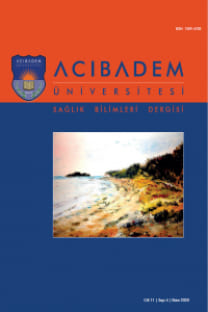COVID-19 Pandemisi Türkiye’de Ortopedi ve Travmatoloji Hekimlerinin Günlük Uygulamalarını Nasıl Değiştirdi?
How Has the COVID-19 Pandemic Revised the Daily Practices of Orthopedics and Traumatology Physicians in Turkey?
___
- 1- Awad ME, Rumley JCL, Vazquez JA, Devine JG. Perioperative Considerations in Urgent Surgical Care of Suspected and Confirmed COVID-19 Orthopaedic Patients: Operating Room Protocols and Recommendations in the Current COVID-19 Pandemic. J Am Acad Orthop Surg. 2020;28(11):451-463. doi:10.5435/JAAOS-D-20-00227
- 2- Rajan N, Joshi GP. COVID-19: Role of Ambulatory Surgery Facilities in This Global Pandemic. Anesth Analg. 2020;131(1):31-36. doi:10.1213/ANE.0000000000004847
- 3- Randelli PS, Compagnoni R. Management of orthopaedic and traumatology patients during the Coronavirus disease (COVID-19) pandemic in northern Italy. Knee Surg Sports Traumatol Arthrosc. 2020;28(6):1683-1689. doi:10.1007/s00167-020-06023-3
- 4- Spina S, Marrazzo F, Migliari M, Stucchi R, Sforza A, Fumagalli R. The response of Milan's Emergency Medical System to the COVID-19 outbreak in Italy. Lancet. 2020;395(10227):e49-e50. doi:10.1016/S0140-6736(20)30493-1
- 5- Tabrizi A, Afshar A. The COVID-19 Outbreak: An Experience for Iranian Health Systems and Orthopedics Association. Arch Iran Med. 2020;23(8):570-571. Published 2020 Aug 1. doi:10.34172/aim.2020.63
- 6- Zhang J, Yam M, Chua IT. Adapting to the "New Normal" in Orthopaedic Trauma During COVID-19. Ann Acad Med Singap. 2020;49(8):611-615.
- 7- Randau TM, Jaenisch M, Haffer H, et al. Collateral effect of COVID-19 on orthopedic and trauma surgery. PLoS One. 2020;15(9):e0238759. Published 2020 Sep 8. doi:10.1371/journal.pone.0238759
- 8- García de Cortázar Antolín U, Arrieta Salinas M, Escobar Sánchez D, Caba Doussoux P. Encuesta acerca del impacto de la COVID-19 en los servicios de Cirugía Ortopédica y Traumatología de España [Survey about the impact of COVID-19 on the traumatology and orthopedic surgery departments in Spain]. J Healthc Qual Res. 2021;36(5):253-262. doi:10.1016/j.jhqr.2021.06.002
- 9- Ranuccio F, Tarducci L, Familiari F, Mastroianni V, Giuzio E. Disruptive Effect of COVID-19 on Orthopaedic Daily Practice: A Cross-Sectional Survey. J Bone Joint Surg Am. 2020;102(14):e77. doi:10.2106/JBJS.20.00604
- 10- Dolci A, Marongiu G, Leinardi L, Lombardo M, Dessì G, Capone A. The Epidemiology of Fractures and Muskulo-Skeletal Traumas During COVID-19 Lockdown: A Detailed Survey of 17.591 Patients in a Wide Italian Metropolitan Area. Geriatr Orthop Surg Rehabil. 2020;11:2151459320972673. Published 2020 Nov 11. doi:10.1177/2151459320972673
- 11- Jain VK, Upadhyaya GK, Iyengar KP, Patralekh MK, Lal H, Vaishya R. Impact of COVID-19 on Clinical Practices during Lockdown: A pan India Survey of Orthopaedic Surgeons. Malays Orthop J. 2021;15(1):55-62. doi:10.5704/MOJ.2103.009
- 12- Liebensteiner MC, Khosravi I, Hirschmann MT, Heuberer PR; Board of the AGA-Society of Arthroscopy and Joint-Surgery, Thaler M. Massive cutback in orthopaedic healthcare services due to the COVID-19 pandemic. Knee Surg Sports Traumatol Arthrosc. 2020;28(6):1705-1711. doi:10.1007/s00167-020-06032-2
- 13- Thaler M, Khosravi I, Hirschmann MT, et al. Disruption of joint arthroplasty services in Europe during the COVID-19 pandemic: an online survey within the European Hip Society (EHS) and the European Knee Associates (EKA). Knee Surg Sports Traumatol Arthrosc. 2020;28(6):1712-1719. doi:10.1007/s00167-020-06033-1
- 14- Turgut A, Arlı H, Altundağ Ü, Hancıoğlu S, Egeli E, Kalenderer Ö. Effect of COVID-19 pandemic on the fracture demographics: Data from a tertiary care hospital in Turkey. Acta Orthop Traumatol Turc. 2020;54(4):355-363. doi:10.5152/j.aott.2020.20209
- 15- Brown TS, Bedard NA, Rojas EO, et al. The Effect of the COVID-19 Pandemic on Electively Scheduled Hip and Knee Arthroplasty Patients in the United States. J Arthroplasty. 2020;35(7S):S49-S55. doi:10.1016/j.arth.2020.04.052
- ISSN: 1309-470X
- Yayın Aralığı: 4
- Başlangıç: 2010
- Yayıncı: ACIBADEM MEHMET ALİ AYDINLAR ÜNİVERSİTESİ
Bilişsel Esneklik, Anksiyete Duyarlılığı ve COVİD-19 Fobisi Arasındaki İlişkinin İncelenmesi
İbrahim Alper YAVUZ, Cahit KOÇAK, Fatih İNCİ, Erman CEYHAN, Ahmet Özgür YILDIRIM, Özdamar Fuad ÖKEN
İlk Halka Arzlarda Düşük Fiyatlama Anomalisi : Borsa İstanbul Sağlık Sektörü Üzerine Bir Uygulama
Mustafa ÖZYEŞİL, Havane TEMBELO
Serkan ERKUŞ, Tayfun BACAKSIZ, Önder KALENDERER, Ali TURGUT
Elif IŞIK DEMİRARSLAN, Sevil ÇINAR ÖZBAY, Deniz YORULMAZ
Şura KAYA, Ayşe DOST, Selma BAZ
Hipoksik-İskemik Beyin Hasarında Kötü Prognozun Elektroenseflaogram ve Nöro-görüntüleme Belirteçleri
